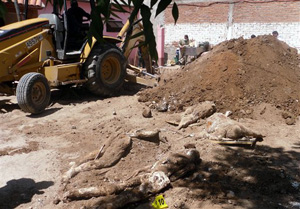| Home | Blog | Ask This | Showcase | Commentary | Comments | About Us | Contributors | Contact Us |

How many Mexicans must die for America’s drugs?COMMENTARY | June 172, 2012The U.S. drug war has spawned incredible violence and political instability throughout the Americas. But as public health expert Ernest Drucker writes, leaders in Mexico and elsewhere are looking for a way out -- and with good reason. By Ernest Drucker The New York Times recently reported that all three Mexican presidential candidates are promising a major shift in the country’s drug war strategy, "placing a higher priority on reducing the violence in Mexico than on using arrests and seizures to block the flow of drugs to the United States." Similarly, New York Review of Books writer Alma Guillermoprieto recently described the "startling, unprogrammed, and rebellious discussion about drugs that took place among hemispheric leaders in April at a summit in Cartagena, Colombia," at which leaders debated "whether the best way to stop the rolling disaster was an end to the US-sponsored and -dictated war on drugs, and at least partial legalization, or regulation, of the drug trade." These moves are long overdue. The entire region must find a way out of the increasingly violent drug trade and the war on drugs. No issue is more central to future relations in the Western Hemisphere. The United States acts as if it were necessary and possible to have a world free of drugs. But prohibition doesn't work. After more than 35 years of full-blown armed conflict, the war on drugs continues and worsens -- a seemingly endless struggle between those who would supply virtually insatiable (and highly profitable) drug markets and those who would ban this vast global commerce. Indeed, the harder authorities fight the war on drugs, the more it drives up the profits that fuel the drug trade, and the more bold and vicious that trade gets. Meanwhile, the U.S. continues to be the world’s largest market for illegal drugs: $40-60 billion dollars a year with an estimated 13 million customers. This huge and lucrative trade in illicit drugs now influences the entire region’s political and economic circumstances, in much the same way that oil has determined them in the Middle East. Lately, Mexico in particular has been embroiled in a very violent phase of the struggles for this huge market. Mexico and Central America occupy a very strategic position in the global drug trade -- sitting astride the principal production and shipment routes supplying billions of dollars of cocaine, heroin, and cannabis to North America and elsewhere in the world. Now Mexico and several other Central American countries are seeing their social and economic fabric collapsing under this stress: corruption is rampant and the rule of law seriously eroded. The most dangerous areas are along the Mexican side of U.S. border, where the carnage is leading to large areas becoming depopulated as many flee their homes. Surprisingly, it was not so long ago that many U.S. cities experienced similar levels of drug trade violence associated with the trade in cocaine and crack. The annual rate of homicides in the U.S. went from a low of 4.6 per 100,000 people (in 1962) to 10.2 per 100,000 in 1980 - at the debut of the explosive growth of the U.S. cocaine trade. Overall up to 200,000 additional homicides occurred in the U.S. during the peak years of our war on drugs between 1966 -- 1993. But by 1994, with the U.S. drug markets stabilized and cocaine use diminished, the murder rate dropped rapidly, and by 2010 it was down to 4.8 per 100.000 -- the lowest rate in 40 years. By contrast, fatal overdoses -- a measure of continued high rates of drug use -- increased steadily in the U.S. and soon outnumbered drug trade related homicides. The dangerous drugs kept coming north, but the fight over who would provide them went south. The escalation over the last five years in the intensity of violence in Mexico represents a new phase in the battle between the large drug cartels and the Mexican government's efforts to contain them, using the national police and armed forces supported with significant U.S. aid. In this period the casualty rates (measured by reported murders) in Mexico have taken a huge leap. Today in Mexico, the drug war is distinguished by both the sheer scale of these deaths and the ferocious purposive quality of the carnage. Over 50,000 Mexicans have been murdered in the last six years -- some estimates go as high as 67,000 -- with over 12,000 killed in 2011 alone. These murders are often group massacres done in the most brutal fashions and most gruesomely displayed (signs of terrible torture, heads cut off ) with the cold-blooded intention of terrifying the public and intimidating all opposition. (See "Cocaine Incorporated," New York Times, June 17, 2012.) Echoing the toll of the era of U.S. domestic violence at the peak of our own drug wars, Mexico’s baseline homicide rate of 18 to 21 deaths per 100,000 has more than doubled since 2005, before the current period of the most active military phase of Mexican opposition to the cartels, according to data from the Mexico National Police and PAHO. The geographic pattern of this violence draws a clear picture of the trade routes from South America north through Mexico to US market. The National System of Public Security in Mexico reports a clear link to the localization of drug cartels and their operations to these deaths. Chihuahua, the epicenter of drug war violence due to it’s many crossing points into Texas , in 2010 had 112 homicides per 100,000, the top rate in Mexico and roughly twice as high as any country on the planet. Sinaloa, on the route to California and Arizona, has also experienced a rapid upsurge in drug violence , and was second with a murder rate of 87 per 100,000. And Mexico is not alone nor even the worst case of the high level of violence of the war on drugs in the Americas. The average homicide rate of the Central American countries (other than Mexico) is 25 people per 100,000 inhabitants a year, already higher than that of Mexico’s new all time high. Two of Mexico’s neighbors to the south, Honduras and El Salvador, now have the highest national murder rates in the world. If the increased violence of the drug wars is superimposed on the previous decades of political violence, it can be seen as evidence of the continuous and widespread social trauma that these societies and their citizens have suffered for so long. The regional war on drugs is not a war of national adversaries, but a civil war about access to trade opportunities and profits for populations otherwise excluded from the great wealth associated with other businesses in the region. Drug criminalization and prohibition establish and sustain these new economic opportunities and continue to drive the high prices of otherwise inexpensive commodities -- a value proposition that sustains the violence and corruption of the global trade. The levels of violence flow directly from the continued opposition of local entrepreneurs and cartels to the steadfast commitment of the world's most powerful nations to the global policy of drug prohibition. In addition to the violent consequences of this war, we all can now see the utter failure of strategies based on drug prohibition to achieve any of the legitimate goals of drug control -- lessening the all-too-real damages that potent drugs can cause to individuals and families by minimizing the risks and massive public health burdens of the most dangerous forms of drug use ( e.g. injecting drugs and AIDS). The present surge in homicides in Mexico and the region is yet another tale of America’s maintaining our own expensive drug habits at the expense of our neighboring nations' fundamental well being. But the July 1 presidential election in Mexico, with its call for changing drug policies to stop violence, may turn out to be a turning point, and the beginning of the end of what would otherwise be an eternal war.
|
||||||||||||




